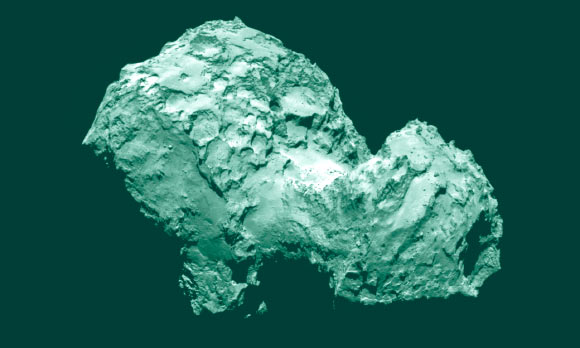European scientists using the Rosetta Orbiter Sensor for Ion and Neutral Analysis (ROSINA) have found that Comet 67P/Churyumov-Gerasimenko, the target comet of ESA’s Rosetta mission, smells like a combination of rotten eggs, alcohol, horse urine, bitter almonds and vinegar.

Comet 67P/Churyumov-Gerasimenko on 3 August 2014 from a distance of 285 km. Image credit: ESA / Rosetta / MPS for OSIRIS team / MPS / UPD / LAM / IAA / SSO / INTA / UPM / DASP / IDA.
“The perfume of this comet is quite strong, with the odor of rotten eggs, of horse stable and the pungent, suffocating odor of formaldehyde,” said Dr Kathrin Altwegg of the University of Bern.
“This is mixed with the faint, bitter, almond-like aroma of hydrogen cyanide.”
“Add some whiff of alcohol to this mixture paired with the vinegar like aroma of sulfur dioxide and a hint of the sweet aromatic scent of carbon disulphide and you arrive at the perfume of our comet.”
Even though 67P/Churyumov-Gerasimenko is still more than 400 million km from the Sun, the mixture of molecules detected in its coma is surprisingly rich.
Dr Altwegg and her colleagues thought that at these vast distances from the Sun, its relatively low intensity would only release the most volatile molecules via sublimation, namely carbon dioxide and carbon monoxide.
However, ROSINA’s mass spectrometers have detected many more molecules: water, carbon monoxide, carbon dioxide, ammonia, methane, methanol, formaldehyde, hydrogen sulfide, hydrogen cyanide, sulfur dioxide and carbon disulphide.
“The primary measurement objective of ROSINA’s two spectrometers is to determine the elemental, isotopic and molecular composition of the atmospheres and ionospheres of comets as well as the temperature and bulk velocity of the gas and ions and the homogenous and inhomogenous reactions of gas and ions in the dusty cometary atmosphere and ionosphere.”
“This will allow scientists to investigate the origin of comets, the relationship between cometary and interstellar material and the implications for the origin of the Solar System.”
Further quantitative analysis will show how 67P/Churyumov-Gerasimenko compares with other comets where data are available mostly from remote sensing.
“This comparison will reveal if the comet being a Kuiper belt comet differs from the better known Oort cloud comets, and this will then shed light on the Solar Nebula from which our Solar System emerged,” said the scientists, who presented their results in September at the European Planetary Science Congress.
On 24 October 2014, the ESA released a science fiction short film, Ambition, promoting the Rosetta mission. Directed by Tomek Bagiński and starring Aiden Gillen and Aisling Franciosi, the film was shot on location in Iceland. It was screened yesterday during the British Film Institute’s celebration of Sci-Fi: Days of Fear and Wonder, at the Southbank, London.
_____







